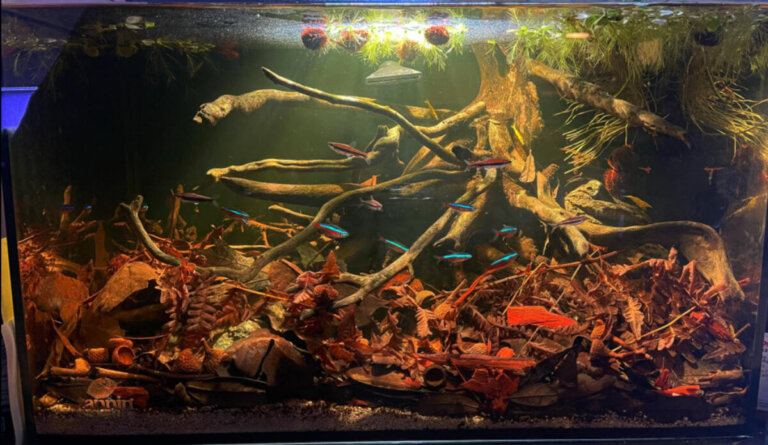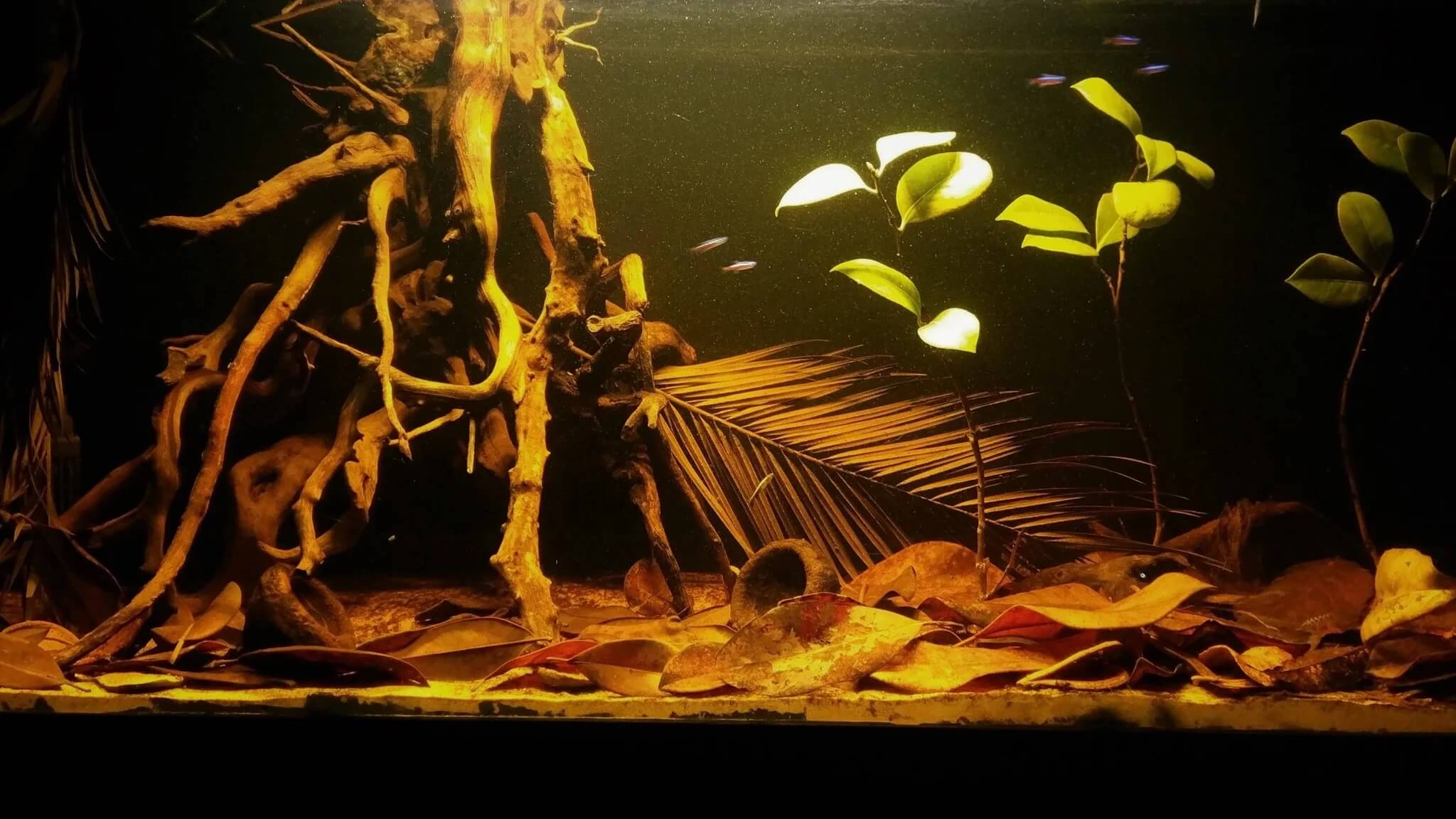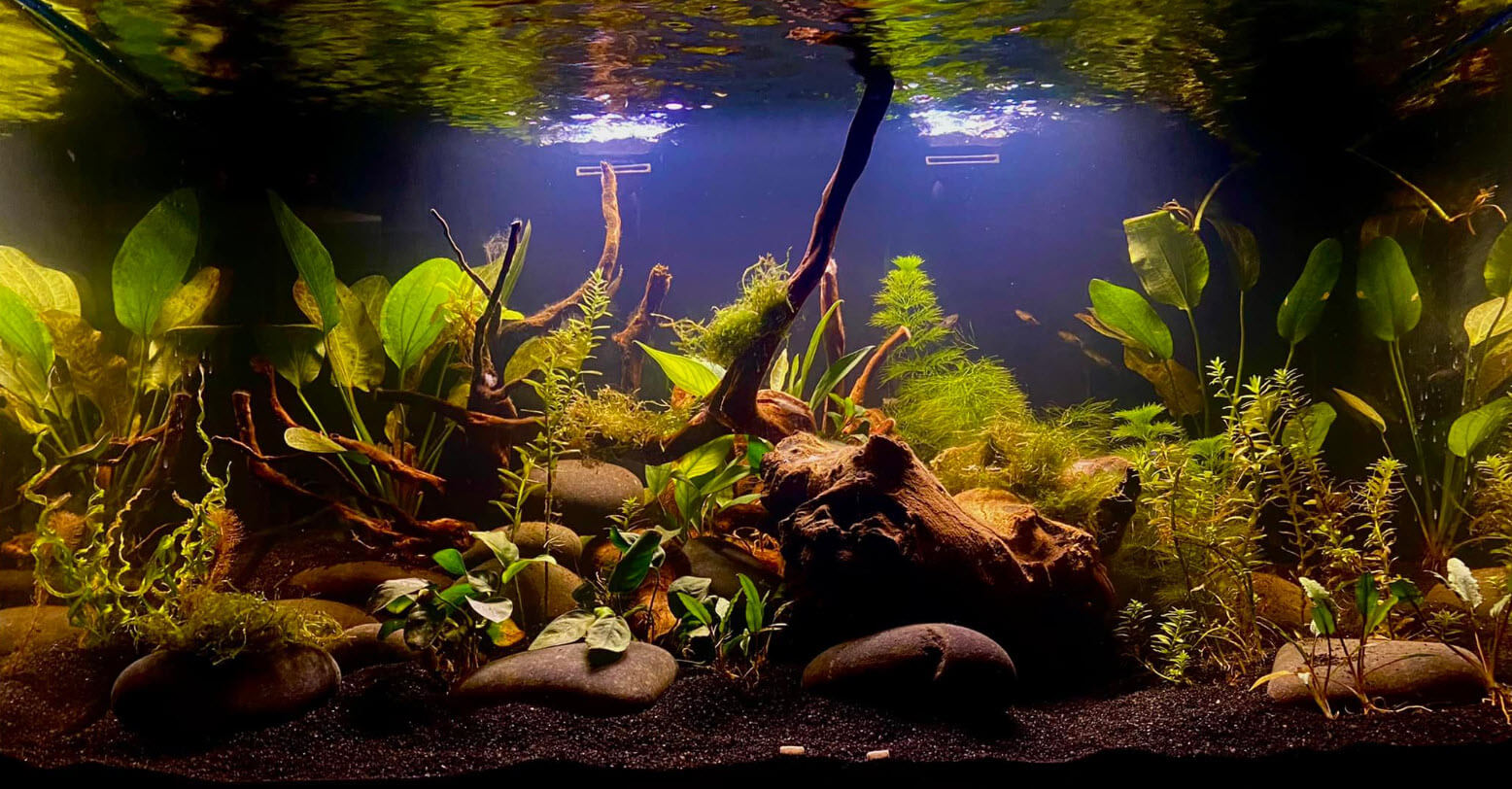Blackwater Aquariums: What They Are, Installation, and Types of Fish


Written and verified by the veterinarian and zootechnician Sebastian Ramirez Ocampo
Unlike conventional fish tanks, blackwater aquariums are characterized by the turbidity of their water as well as the variety of plant and animal species that can be housed inside. Although they need certain conditions for life to thrive, the reality is that these requirements aren’t difficult to achieve.
This article will explore the basics of blackwater aquariums, the key elements for their creation and maintenance, as well as some recommended types of fish for people who wish to immerse themselves in this unexplored branch of aquarium keeping. Don’t miss all the information below!
What are blackwater aquariums?
Blackwater aquariums are ponds that seek to recreate ecosystems of the rivers and streams that are present in the tropics. For example, those tributaries that belong to South America, such as the Amazon or the Orinoco River. They’re distinguished from crystal-clear water aquariums by the following elements:
- Color: In these aquariums, the water turns an orange-brown color. It acquires this color due to the release of natural acids and humic substances, which result from the decomposition of leaves, stems, and branches. These compounds include tannins, which are polyphenols that, in addition to darkening the water, have antioxidant and antibacterial properties.
- pH: As a result of the decomposition of organic matter, the pH of blackwater aquariums is generally acidic. Although it can be maintained at a level of 5, some breeders recommend a pH between 6.5 and 7.
- Temperature: Considering that this tank simulates the state of tropical waters, the temperature should be between 24 °C and 26 °C.
- Illumination: In nature, dark water biotopes have a dim and shadowy illumination for the protection of plant species. Because of this, in an artificial dark water pond, the luminosity must be just as low.
- Vegetation: Although in conventional aquariums, plants play a decorative or environmental enrichment role, in this case, they’re essential to creating the conditions needed by some tropical fish.

How to set up a blackwater aquarium?
As you’ve seen, there are several elements that come together in order for a pond of these characteristics to work properly. Next, we’ll explain the necessary instruments and equipment needed for a black water aquarium in detail.
Size and shape
First of all, there’s no standard size for these ponds. The size will depend on the following factors:
- Space
- Capacity
- The number of fish
The aquarium can be from 5 to 26 gallons. It’s best if it’s rectangular in shape.
Substrate
Ideally, the soil or substrate of the blackwater aquarium should consist of fine gravel so that the plants can anchor their roots. In addition, it should be brown in color in order to closely mimic the natural environment.
Water
The water in these aquariums should be soft and acidic. This means it should have a pH below 7 and a low concentration of dissolved minerals or a hardness between 1 and 8 dGH.
To achieve this, tap water can be treated with a conventional water purifier, which uses reverse osmosis to clean these impurities. As for the pH, as the organic material is broken down, the necessary acidity is obtained.
It should be noted that in order to control these parameters, it’s necessary to perform regular tests with kits that measure the hardness and pH of the water.
Light
As already explained, the light in these aquariums should be dim and low intensity. Too much light can cancel out the effect of the black water and increase the risk of bacteria and algae growth inside the aquarium. Therefore, it’s best to use LED daylight lamps with a color temperature of 6,500 to 7,000 K (Kelvins).
Heater
A typical submersible heater can be used. According to the characteristics of the fish that inhabit these waters, the temperature should be between 75 °F and 79 °F (24 °C and 26 °C)
Filtration
Like any aquarium, blackwater aquariums need a sieve to clean impurities from the water. Mechanical filters are suggested:
- Sponges
- HOB or Hang on back
- Power or cartridge head
In addition, the use of activated carbon for a week every month also proves to be beneficial in removing unwanted organic substances in the aquarium.
Water movement
A small tank will only require the HOB power filter to provide the water movement needed by the pond. However, aquariums of 26 gallons or more require the installation of a cartridge filter to create a stronger water current.
Vegetation
This is one of the most important elements in blackwater aquariums. A correct choice of leaves and plants for the pond will establish a balance for plant and animal life to thrive. As for leaf litter, the following species should be used:
- Hawthorn
- Guava
- Magnolia
- Almond
- European beech
- Alder cones
- Red oak or abar
These leaves, in addition to creating the desired aquarium environment, are also a source of food for some fish. Therefore, collecting leaves from the ground or from areas where pesticide spraying is taking place should be avoided.
At the same time, although there’s no exact measure of the number of leaves to apply, two to three almond leaves per 10.5 gallons of water is recommended. Or, on the other hand, a handful of red oak leaves per 13 gallons or one alder cone per 5.
It’ll take about two days for the leaves to absorb enough water to sink. Don’t forget that they should be changed every month so that the organic matter doesn’t over-contaminate or alter the water quality.
Although it’s not strictly necessary, it’s also possible to plant some species inside the aquarium. This way, the fish will feel more at ease in an almost natural environment. The plants chosen can be those mentioned below:
- Anubias
- Red tiger lotus
- Bucephalandra
- Water moss
- Java fern
- Frog’s-bit
- Water trumpets

Decoration
Aside from plants and leaves, the pond can also be enriched with roots, branches, or natural stems, such as those of mopani wood or bog-wood. In addition, stones or structures can be integrated to serve as hiding or resting places for animals.
What should you take into account for the maintenance of blackwater aquariums?
To begin with, water replacement should be done on a regular basis to eliminate waste and contaminants, which are produced in the aquarium for the following reasons:
- Defecation
- Feeding
- Degradation of organic material
However, this can’t be done completely or in large quantities, as there’s a risk of altering the water parameters. As a general rule, it’s best to change 20% every week and 50% every month.
Another aspect to take into account is to clean the bottom and replace the leaf litter every month or when it looks very deteriorated. In addition, to prevent the growth of harmful microorganisms without altering the beneficial biota of the aquarium, the Aquarium Science website recommends sterilization with UV rays.
Water conditions should be evaluated periodically by testing pH, hardness, or temperature.
Types of fish for blackwater aquariums
There are more than 200 species with the ability to inhabit warm, dark waters with a high load of organic material. The following are the most prominent fish:
- Killifish
- Guramis
- Rasboras
- Geophagous
- Neon fish
- Betta fish
- Discus fish
- Hatchet fish
- Pencil tetra
- Rainbow fish
- Black tetra
- Catfish loricariid
- Dwarf pufferfish
- Firemouth cichlid
An aquarium with special features
Now that you know everything a blackwater aquarium needs, it’s time to set one up in your home. Be sure to remember the elements that make this micro-ecosystem function properly, as well as the plant and animal species you can include.
In particular, this pond will allow you to contemplate the beauty of little-known and unexplored environments in the aquarium world.
Unlike conventional fish tanks, blackwater aquariums are characterized by the turbidity of their water as well as the variety of plant and animal species that can be housed inside. Although they need certain conditions for life to thrive, the reality is that these requirements aren’t difficult to achieve.
This article will explore the basics of blackwater aquariums, the key elements for their creation and maintenance, as well as some recommended types of fish for people who wish to immerse themselves in this unexplored branch of aquarium keeping. Don’t miss all the information below!
What are blackwater aquariums?
Blackwater aquariums are ponds that seek to recreate ecosystems of the rivers and streams that are present in the tropics. For example, those tributaries that belong to South America, such as the Amazon or the Orinoco River. They’re distinguished from crystal-clear water aquariums by the following elements:
- Color: In these aquariums, the water turns an orange-brown color. It acquires this color due to the release of natural acids and humic substances, which result from the decomposition of leaves, stems, and branches. These compounds include tannins, which are polyphenols that, in addition to darkening the water, have antioxidant and antibacterial properties.
- pH: As a result of the decomposition of organic matter, the pH of blackwater aquariums is generally acidic. Although it can be maintained at a level of 5, some breeders recommend a pH between 6.5 and 7.
- Temperature: Considering that this tank simulates the state of tropical waters, the temperature should be between 24 °C and 26 °C.
- Illumination: In nature, dark water biotopes have a dim and shadowy illumination for the protection of plant species. Because of this, in an artificial dark water pond, the luminosity must be just as low.
- Vegetation: Although in conventional aquariums, plants play a decorative or environmental enrichment role, in this case, they’re essential to creating the conditions needed by some tropical fish.

How to set up a blackwater aquarium?
As you’ve seen, there are several elements that come together in order for a pond of these characteristics to work properly. Next, we’ll explain the necessary instruments and equipment needed for a black water aquarium in detail.
Size and shape
First of all, there’s no standard size for these ponds. The size will depend on the following factors:
- Space
- Capacity
- The number of fish
The aquarium can be from 5 to 26 gallons. It’s best if it’s rectangular in shape.
Substrate
Ideally, the soil or substrate of the blackwater aquarium should consist of fine gravel so that the plants can anchor their roots. In addition, it should be brown in color in order to closely mimic the natural environment.
Water
The water in these aquariums should be soft and acidic. This means it should have a pH below 7 and a low concentration of dissolved minerals or a hardness between 1 and 8 dGH.
To achieve this, tap water can be treated with a conventional water purifier, which uses reverse osmosis to clean these impurities. As for the pH, as the organic material is broken down, the necessary acidity is obtained.
It should be noted that in order to control these parameters, it’s necessary to perform regular tests with kits that measure the hardness and pH of the water.
Light
As already explained, the light in these aquariums should be dim and low intensity. Too much light can cancel out the effect of the black water and increase the risk of bacteria and algae growth inside the aquarium. Therefore, it’s best to use LED daylight lamps with a color temperature of 6,500 to 7,000 K (Kelvins).
Heater
A typical submersible heater can be used. According to the characteristics of the fish that inhabit these waters, the temperature should be between 75 °F and 79 °F (24 °C and 26 °C)
Filtration
Like any aquarium, blackwater aquariums need a sieve to clean impurities from the water. Mechanical filters are suggested:
- Sponges
- HOB or Hang on back
- Power or cartridge head
In addition, the use of activated carbon for a week every month also proves to be beneficial in removing unwanted organic substances in the aquarium.
Water movement
A small tank will only require the HOB power filter to provide the water movement needed by the pond. However, aquariums of 26 gallons or more require the installation of a cartridge filter to create a stronger water current.
Vegetation
This is one of the most important elements in blackwater aquariums. A correct choice of leaves and plants for the pond will establish a balance for plant and animal life to thrive. As for leaf litter, the following species should be used:
- Hawthorn
- Guava
- Magnolia
- Almond
- European beech
- Alder cones
- Red oak or abar
These leaves, in addition to creating the desired aquarium environment, are also a source of food for some fish. Therefore, collecting leaves from the ground or from areas where pesticide spraying is taking place should be avoided.
At the same time, although there’s no exact measure of the number of leaves to apply, two to three almond leaves per 10.5 gallons of water is recommended. Or, on the other hand, a handful of red oak leaves per 13 gallons or one alder cone per 5.
It’ll take about two days for the leaves to absorb enough water to sink. Don’t forget that they should be changed every month so that the organic matter doesn’t over-contaminate or alter the water quality.
Although it’s not strictly necessary, it’s also possible to plant some species inside the aquarium. This way, the fish will feel more at ease in an almost natural environment. The plants chosen can be those mentioned below:
- Anubias
- Red tiger lotus
- Bucephalandra
- Water moss
- Java fern
- Frog’s-bit
- Water trumpets

Decoration
Aside from plants and leaves, the pond can also be enriched with roots, branches, or natural stems, such as those of mopani wood or bog-wood. In addition, stones or structures can be integrated to serve as hiding or resting places for animals.
What should you take into account for the maintenance of blackwater aquariums?
To begin with, water replacement should be done on a regular basis to eliminate waste and contaminants, which are produced in the aquarium for the following reasons:
- Defecation
- Feeding
- Degradation of organic material
However, this can’t be done completely or in large quantities, as there’s a risk of altering the water parameters. As a general rule, it’s best to change 20% every week and 50% every month.
Another aspect to take into account is to clean the bottom and replace the leaf litter every month or when it looks very deteriorated. In addition, to prevent the growth of harmful microorganisms without altering the beneficial biota of the aquarium, the Aquarium Science website recommends sterilization with UV rays.
Water conditions should be evaluated periodically by testing pH, hardness, or temperature.
Types of fish for blackwater aquariums
There are more than 200 species with the ability to inhabit warm, dark waters with a high load of organic material. The following are the most prominent fish:
- Killifish
- Guramis
- Rasboras
- Geophagous
- Neon fish
- Betta fish
- Discus fish
- Hatchet fish
- Pencil tetra
- Rainbow fish
- Black tetra
- Catfish loricariid
- Dwarf pufferfish
- Firemouth cichlid
An aquarium with special features
Now that you know everything a blackwater aquarium needs, it’s time to set one up in your home. Be sure to remember the elements that make this micro-ecosystem function properly, as well as the plant and animal species you can include.
In particular, this pond will allow you to contemplate the beauty of little-known and unexplored environments in the aquarium world.
All cited sources were thoroughly reviewed by our team to ensure their quality, reliability, currency, and validity. The bibliography of this article was considered reliable and of academic or scientific accuracy.
- Aquarium Science. (s.f.). Blackwater Fish. Consultado el 6 de agosto de 2023. https://aquariumscience.org/index.php/17-3-blackwater-fish/
- CO2art. (2022). How to create a blackwater aquarium? Consultado el 6 de agosto de 2023. https://www.co2art.us/blogs/blog/how-to-create-a-blackwater-aquarium
- Fielding, M. (2021). Blackwater Aquarium: The Complete Guide. Fish Topics. Consultado el 5 de agosto de 2023. https://fishtopics.com/blackwater-aquarium/
- Flickerton, B. (2022). Black Water Aquariums: How to Setup a Biotope Tank. Fish Tank Advisor. Consultado el 6 de agosto de 2023. https://fishtankadvisor.com/blackwater-aquarium/
- Hall, J. (2022). Blackwater Aquarium: The Ultimate Guide. Epic Fish Keeping. Consultado el 5 de agosto de 2023. https://epicfishkeeping.com/blackwater-aquarium-guide/
- Kumar, P., & Upadhyaya, K. (2012). Tannins are Astringent. Journal of Pharmacognosy and Phytochemistry, 1 (3), 45-50. https://www.researchgate.net/publication/264783867_Tannins_are_Astringent
- Leighton, M. (s.f.). Blackwater Aquarium Guide: Setting Up Your Own Blackwater Biotope. Vivo Fish. Consultado el 6 de agosto de 2023. https://www.vivofish.com/blackwater-aquarium-guide/
This text is provided for informational purposes only and does not replace consultation with a professional. If in doubt, consult your specialist.








